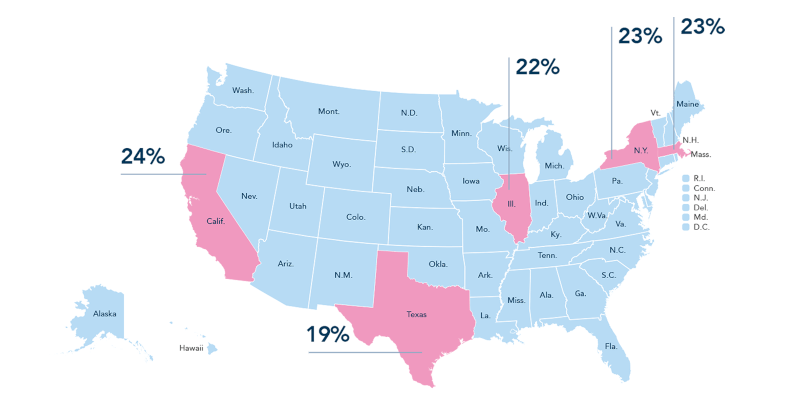The State of Gender Diversity
July 10, 2020
Daniella Gama-Diaz

Equilar recently announced its latest Gender Diversity Index (GDI) for the first quarter of the new decade. In Q1 2020, women occupied 22% of all Russell 3000 board seats. This progression moved the GDI to its highest point since inception at 0.44, where 1.0 represents parity among men and women. Across America, states are reaching higher peaks on the gender diversity front. This study examines the representation of women on Russell 3000 boards across individual U.S. states.
The Percentage of Women on Boards by U.S. State
|
State
|
Number of Companies
|
Number of Board Seats
|
Representation of Women
|
New Mexico ranked first in the nation with 40% female representation on boards. Delaware followed closely behind. However, some states have a higher prevalence of Russell 3000 corporate headquarters. While New Mexico ranked the highest in the country for gender diversity, just one Russell 3000 company is headquartered in the state. Similarly, Delaware has just ten companies.
On the other hand, some states have a much higher number of boards in the state. For example, California is home to 470 public Russell 3000 companies, the most among any U.S. state. Texas, New York and Massachusetts follow with hundreds of companies as well. These states, despite having the largest amounts of public companies, did not rank as high for gender diversity. This deeper dive into the exploration of gender diversity across states will examine the proportion of women on boards, as well as efforts made to reach gender parity.
California ranks 17th in the nation in terms of gender diversity, with 24% female representation on boards. Although this seems comparatively low to the high of 40%, California also houses the most public companies out of any U.S. state as previously mentioned. With so many more boardrooms, it may be more difficult for California to get their almost 500 companies to push for gender parity equally.
Similarly, Texas ranks 42nd in the nation in terms of gender diversity, with 19% female representation on boards. Although this was amongst the lowest in the country, Texas also had the second highest prevalence of Russell 3000 public boards, with 272 companies.
New York ranks 20th in the nation in terms of gender diversity, with 23% female representation on boards. However, the state also is home to 255 public companies, which is no surprise due to the state having the largest city in the country and a major hub for corporate activities, both in the nation and around the world. However, women only account for 40% of management, business and financial operations occupations. In 2019, 34.3% of directors had previous CEO experience. For women to climb the corporate ladder and ascend into a director position, there may be a barrier at each rung. Despite the higher number of companies, the increased competition and fewer opportunities for women may lead to less women rising to the position of director.
Massachusetts, with 188 public companies, ranks 19th in the nation in terms of gender diversity, with 23% female representation on boards. With 125 public companies, Illinois ranks 28th in the nation in with 22% female representation on boards. This continues the trend that having a higher prevalence of companies naturally may mean that the gender diversity rate will be lower than states with fewer companies. For states with fewer public companies, it may be easier to achieve more women on boards. But for these larger states, it is not enough to rely on public opinion and company goodwill to push for gender equality in the boardroom. Coincidentally, the top five states in terms of public companies have also been the states with the most legislation passed to level the playing field.
In 2018, California became the first state to pass legislation regarding diversity on boards. The state passed a law mandating the placement of women on boards, specifying that every public company must have at least one female director by the end of 2019, and at least two on a five-person board and three on a six-person board by 2021. Failure to comply results in steep fines, ranging from $100,000 up to $300,000 per female not on board. Already, California has seen positive results from this measure. When legislation was passed, representation of women on boards was just under 17%.
Washington State recently passed similar legislation that requires all public boards in the state must be comprised of at least 25% of individuals who identify themselves as women by January 1, 2022. Illinois followed suit and passed a law last fall that requires public companies to disclose gender and ethnicity data for boards. While the bill originally also required that at least one woman serve on each board, the law was eventually whittled down to include only the disclosure mandate. However, this is the first step in the state moving towards gender parity, as stronger legislation is possible in the future.
New York has made similar progress, as they have launched a study to analyze the statistics of females on boards. In late June, this will culminate in a law that will require companies to provide these disclosures in a report. Massachusetts is planning on passing a similar law soon, as several bills have been proposed to mandate more women on public boards for companies headquartered in the state.
In Texas, there are several groups that are advocating for gender diversity on boards. From startups to tech firms, companies are pushing to have greater female representations on their boards. With major industries jumping on board, eventually, more companies may follow suit.
There are several factors that explain why there are fewer women on boards than men. From historical factors, to fewer opportunities for women, women have had an uphill battle to have equal representation across corporate America. As long as the states that house the most public companies in the U.S. set the example for increased gender diversity, there may soon be a major change across the country.
Contact

Daniella Gama-Diaz
Associate Editor at Equilar
Daniella Gama-Diaz, Associate Editor at Equilar, authored this post. Please contact Amit Batish at abatish@equilar.com for more information about this article.
 Solutions
Solutions











